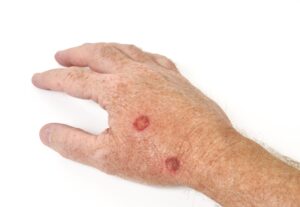
Clear Cell Acanthoma, also called Acanthome Cellules Claires of Degos and Civatte, Degos Acanthoma and Pale Cell Acanthoma, is a benign skin lesion that often appears on the lower extremities of middle aged and elderly patients. Many patients with Clear Cell Acanthoma, who come to see Dr. Perri are concerned that they have skin cancer. But, Clear Cell Acanthoma is not skin cancer and is not harmful. Clear Cell Acanthoma typically presents as a slightly elevated to dome-shaped skin lesion, with colors ranging from pink to brown – though it is most commonly blood red and shiny. Clear Cell Acanthomas can be anywhere from 3mm to 20mm in diameter, and often have a wafer-like and crusty scale around the edges of the lesion. If the scale is removed, the lesion may become moist or bleed.
How is Clear Cell Acanthoma Diagnosed?
Clear Cell Acanthoma is rarely diagnosed before a skin biopsy. Because of this, the most common treatment for Clear Cell Acanthoma is excision (cutting off the lesion). During an excision, you will receive a local anesthetic to numb the skin around the lesion. The entire lesion will be surgically removed with a scalpel, often with a few mm of surrounding skin. This is done for biopsy purposes. If the biopsy finds that the lesion was not a benign Clear Cell Acanthoma and is instead skin cancer, the lab will test the surrounding skin to see if the skin cancer has spread. After the excision, you will receive sutures to close the wound, and pressure will be applied to the wound to stop the bleeding.
During a skin cell biopsy, your lesion will be examined under a microscope to check for any abnormal or skin cancer cells. Biopsy results should be available within 14 days after the excision.
As you are healing from your excision, your dermatologist will provide you with special care instructions. Your stitches will remain in place for 3 to 14 days, depending on the biopsy site and the size of the excision. Before you leave your appointment, you should ask your doctor how much blood or drainage is expected to take place from the affected area underneath your adhesive bandages. Call your dermatologist immediately if you have excessive bleeding or drainage seeping through the bandages, and apply pressure to the bandage, or if you have increased tenderness, pain or swelling at the excision site, or a fever which may indicate that you have developed an infection.
What Should I Do If I Suspect I Have Clear Cell Acanthoma?
If you have a skin lesion that you suspect is Clear Cell Acanthoma, the best thing for you to do is call Dr. Perri’s offices to schedule an appointment today. Don’t put off seeing Dr. Perri just because Clear Cell Acanthoma is benign. Remember, only a biopsy can definitively diagnose Clear Cell Acanthoma, so it is important that you have the skin lesion removed immediately to confirm it is not skin cancer.




